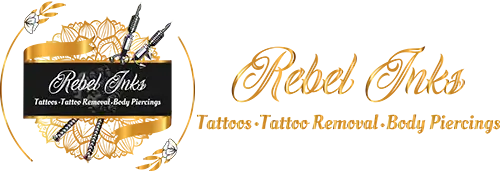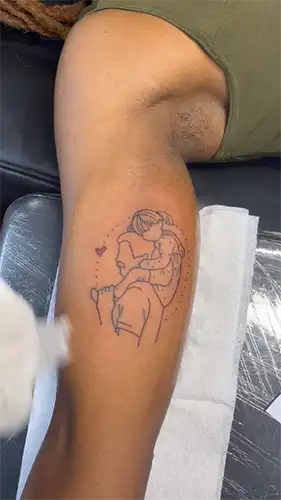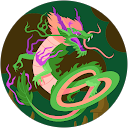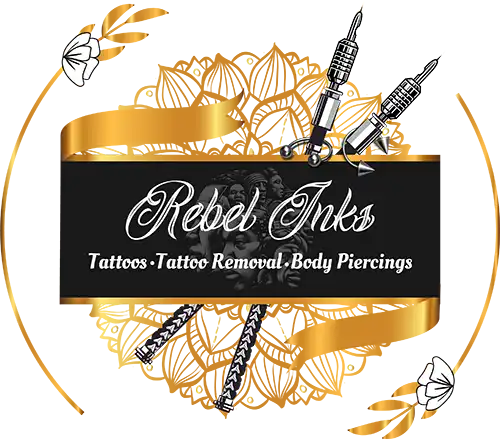Line Art Tattoos in Nairobi, Kenya
Line art tattoo style, also known as blackwork or black line tattoo style, is a popular tattooing technique that focuses primarily on using black ink to create bold and intricate designs composed mainly of lines. This style often eschews shading, color, and gradients, relying instead on the precise placement of solid black lines to form the image.
Line Art Tattoo Style
Line art tattoos typically emphasize clean, crisp lines and negative space to create visually striking and minimalist designs. They can range from simple geometric patterns and symbols to highly detailed illustrations and intricate patterns. The style draws inspiration from various sources, including tribal art, traditional tattooing, woodcut illustrations, and even contemporary graphic design.
Artists specializing in line art tattoos often employ different line weights and styles, such as single lines, parallel lines, dotwork, or hatching, to add depth, texture, and visual interest to the design. The result is a bold and graphic aesthetic that can be both visually captivating and timeless.
Line art tattoos have gained significant popularity in recent years due to their versatility, ability to age well, and the striking contrast they create against the skin. Whether it’s a delicate floral design, a complex geometric pattern, or an intricate animal illustration, line art tattoos offer a distinct and unique look that appeals to a wide range of tattoo enthusiasts.
Here are some useful tips if you’re planning to get a Line Art Tattoos:
Getting a line art tattoo requires some careful consideration to ensure the design stays crisp and clean over time. Here are some tips to help you achieve the best results:
- Choose an Experienced Artist
– Specialization: Select an artist who specializes in line art tattoos. Line work requires a steady hand and precision, so finding someone experienced in this style is crucial.
– Portfolio Review: Look through the artist’s portfolio to see examples of their previous line art tattoos. Pay attention to the sharpness and consistency of the lines. - Consider the Design Size and Complexity
– Simplicity: Line art tattoos work best when they’re simple. Intricate designs can blur over time as the ink spreads under the skin.
– Size: Smaller tattoos may lose detail over time. Consider slightly larger designs to maintain the clarity of the lines. - Placement Matters
– Skin Quality: The quality of your skin can affect how well the lines hold up. Areas with thinner skin (like the wrist or foot) may blur more quickly.
– Movement Areas: Avoid areas where the skin stretches or moves frequently, like elbows or knees, as this can cause the lines to blur or fade faster. - Line Thickness
– Consistency: Opt for consistent line thickness throughout the tattoo. Extremely thin lines are more prone to fading or blurring, while thicker lines are more durable.
– Style Choice: Decide if you want uniform lines or a mix of thick and thin lines for added dimension. - Prepare for Healing
– Aftercare: Proper aftercare is essential for line art tattoos. Follow your artist’s aftercare instructions carefully to ensure the lines heal cleanly without scabbing or fading.
– Avoid Stretching: During the healing process, avoid stretching the skin where the tattoo is located, as this can affect the line integrity. - Touch-Ups
– Expect Maintenance: Line art tattoos may require touch-ups over time to maintain their crispness. Don’t hesitate to return to your artist for a touch-up if you notice any fading or blurring. - Think Long-Term
Aging Skin: Consider how the tattoo will look as your skin ages. Line tattoos are prone to spreading and blurring over the years, so choose a design that will still look good even as the lines soften. - Test the Design
– Temporary Tattoos: Try out the design as a temporary tattoo to see how it looks on your skin and in different positions. This can help you finalize the size and placement before committing.
By following these tips, you can ensure that your line art tattoo remains a beautiful and lasting piece of body art.
Line Art Tattoo Design Techniques
Black and gray tattoo techniques encompass a range of artistic approaches and methods used to create stunning monochromatic designs. These techniques, when skillfully employed, contribute to the depth, texture, and visual impact of black and gray tattoos. Here are some key techniques commonly utilized in this style:
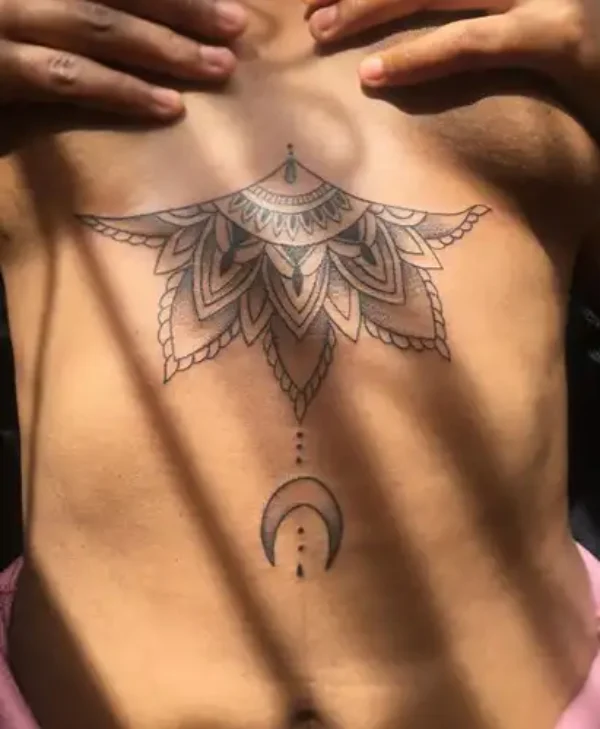
Mandala
A mandala is a geometric design that symbolizes unity and balance. A line art mandala tattoo features intricate patterns formed by interconnected lines, creating a mesmerizing and symmetrical composition.
Constellations
A line art tattoo depicting constellations captures the beauty of the night sky. The design consists of minimalist lines that form the outline of specific star formations, such as the Big Dipper or Orion’s Belt.
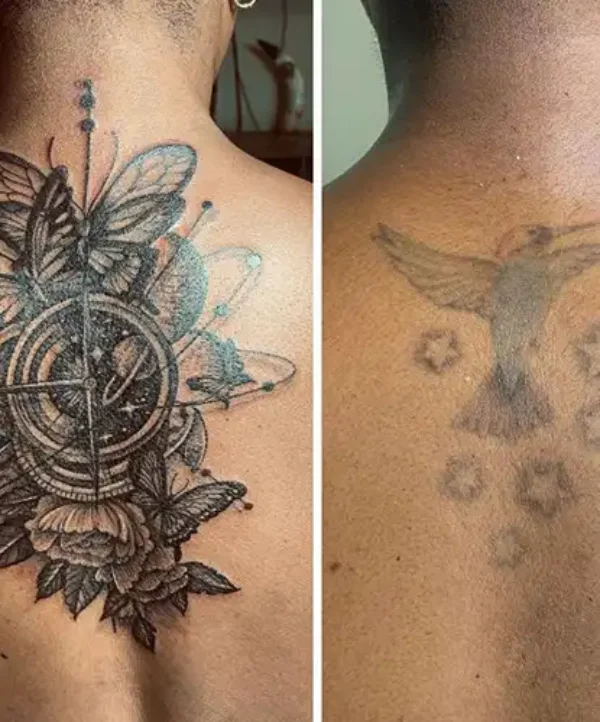


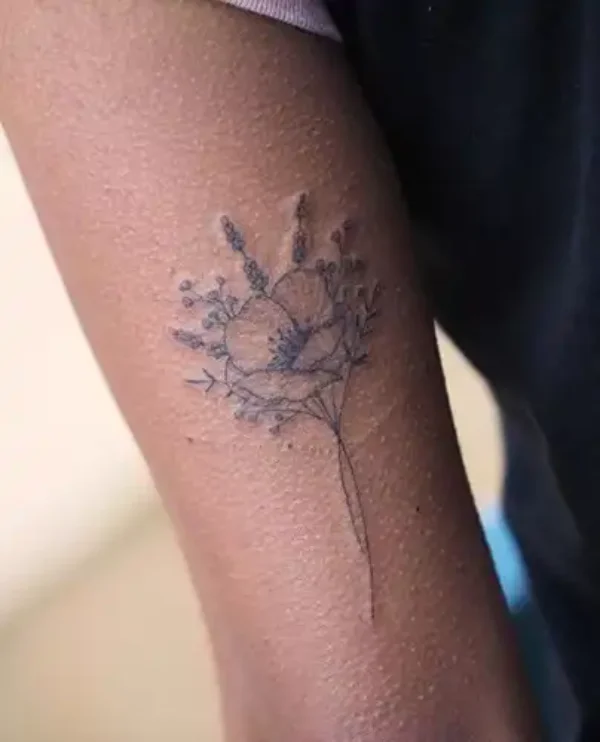


Botanical Illustrations
Line art tattoos can showcase the elegance of flowers, leaves, or branches. For instance, a delicate line art rose tattoo features precise lines to depict the petals, thorns, and leaves, creating a simple yet captivating floral design.
Animals
Animals can be beautifully represented through line art tattoos. A line art lion tattoo, for example, showcases the majestic mane and fierce expression of the lion, using bold lines and negative space to capture its essence.
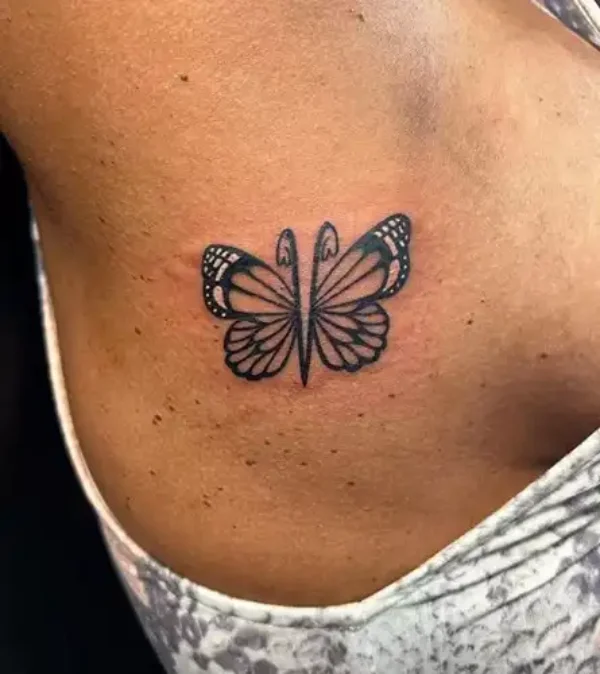


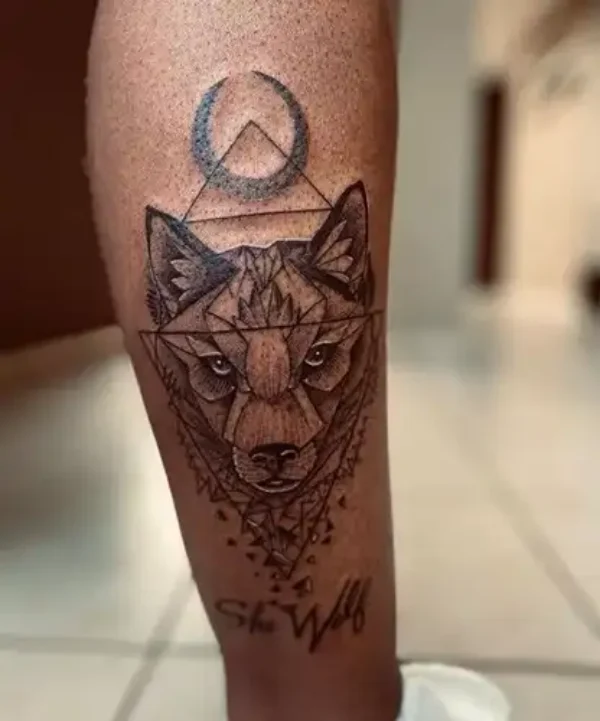


Geometric Shapes
Geometric shapes and patterns lend themselves well to line art tattoos. A design featuring intersecting lines, triangles, circles, and squares can create a visually striking and abstract composition.
Mythological Creatures
Line art tattoos of mythological creatures, such as dragons or phoenixes, can be intricately detailed and visually captivating. The precise lines emphasize the mythical qualities of these creatures and add depth to the design.
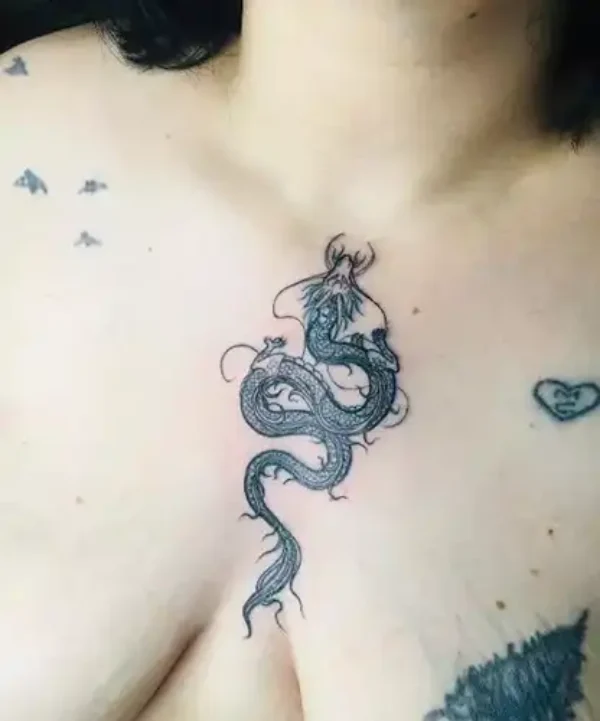


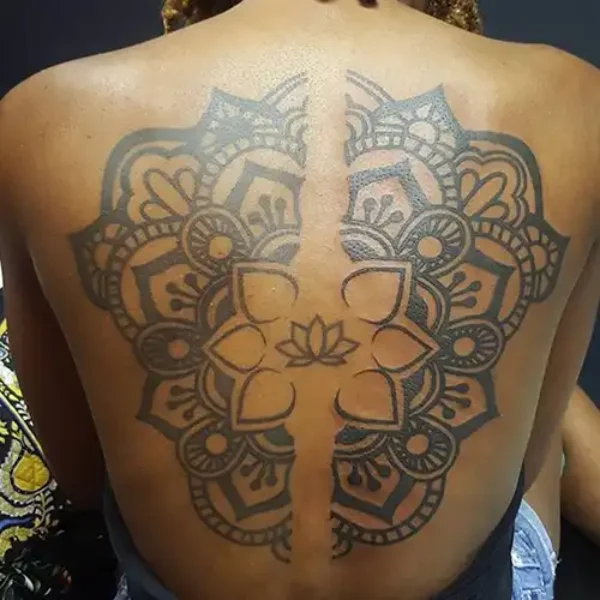


Abstract Designs
Line art tattoos can also explore abstract concepts and compositions. A minimalist line art tattoo featuring intersecting lines, curves, and angles can create a unique and thought-provoking design.
These are just a few examples, and line art tattoo designs can encompass a wide range of subjects and styles. It’s essential to work closely with a skilled tattoo artist who can bring your vision to life and ensure the lines and composition suit your preferences.
Schedule Appointment
Line Art Tattoo Design FAQ’s
How Thin Can a Line Art Tattoo Design Be?
The thickness of a line art tattoo design can vary based on personal preference and the artist’s technique. However, when it comes to line art, the focus is typically on creating clean and precise lines that stand out and maintain their integrity over time.
In general, line art tattoos often feature relatively thin lines to achieve the desired level of detail and intricacy. The thickness of the lines can range from as thin as a single needle’s width to a few millimeters, depending on the size and complexity of the design.
It’s important to consider various factors when determining the appropriate thickness for a line art tattoo. These factors include the placement of the tattoo, the artist’s skill level, and the overall design aesthetic. For example, smaller tattoos or those intended for delicate areas of the body may require finer lines to ensure clarity and prevent the design from blending or blurring over time.
Additionally, it’s worth noting that thinner lines may require more frequent touch-ups compared to thicker lines, as they may fade or blur slightly over time due to the natural healing process of the skin and exposure to the sun.
Ultimately, discussing your desired line thickness and design details with a professional tattoo artist is crucial. Their expertise and experience will help determine the optimal line thickness to achieve the desired effect while considering the long-term quality and longevity of the tattoo.
Line Art Tattoos Pain Threshold
Tattoo pain can vary from person to person and depends on various factors, including individual pain tolerance, the location of the tattoo, and the specific technique used by the artist. While line art tattoos typically involve less shading and color work compared to other styles, the level of discomfort can still vary.
In general, line work tattoos are known to be less painful than tattoos with extensive shading or solid color fillings. The process of creating clean, precise lines involves a consistent needle motion that may cause less discomfort compared to the repeated needle punctures required for shading or color saturation.
However, it’s important to note that pain is subjective, and everyone experiences it differently. Sensations during the tattooing process are often described as a combination of stinging, scratching, or vibrating sensations. The level of discomfort can also be influenced by the area being tattooed. Bony areas or locations with thinner skin, such as the ribs, hands, or feet, tend to be more sensitive and may cause more discomfort during the tattooing process.
To manage potential pain or discomfort during a line art tattoo session, here are a few suggestions:
- Communication: It’s essential to communicate openly with your tattoo artist about your pain tolerance and any concerns you may have. They can adjust their technique, take breaks if needed, or provide suggestions for managing discomfort.
- Numbing Cream: Some individuals choose to use a numbing cream or topical anesthetic before their tattoo session to help minimize pain. Discuss this option with your tattoo artist or consult a medical professional for guidance.
- Relaxation Techniques: Employing relaxation techniques, such as deep breathing or focusing on a specific point, can help distract from any discomfort and promote a sense of calm during the tattooing process.
Remember, while tattoos can be uncomfortable, the pain is typically temporary, and many people find the end result to be well worth it. It’s essential to choose a reputable tattoo artist, follow their aftercare instructions carefully, and prioritize your comfort throughout the process.
Line Art Tattoos Healing
Line art tattoos do not necessarily heal faster than other tattoo styles. The healing process for a tattoo depends on various factors, including the individual’s overall health, the size and intricacy of the design, the tattoo placement, and how well the aftercare instructions are followed.
Generally, the healing process for line art tattoos is similar to other tattoo styles. During the initial healing stage, which typically lasts around two to three weeks, the skin undergoes a natural process of scabbing, peeling, and regenerating new skin cells. It’s crucial to keep the tattoo clean, moisturized, and protected during this time to ensure proper healing.
While line art tattoos may have less shading or color saturation, they still involve the same process of the skin healing and repairing itself. It’s important to note that healing time can vary for each individual, and some factors may influence the overall healing duration, such as the person’s immune system, skin type, and the tattoo’s location.
To promote optimal healing for a line art tattoo or any tattoo style, it’s recommended to:
- Follow Aftercare Instructions: Your tattoo artist will provide specific aftercare instructions tailored to your tattoo. This typically includes washing the tattoo gently with mild soap, applying a thin layer of recommended ointment or moisturizer, and avoiding excessive sun exposure, swimming, or activities that may irritate the healing skin.
- Keep the Tattoo Clean: Maintaining cleanliness is essential to prevent infection. Wash your hands thoroughly before touching the tattoo, use clean towels or paper towels, and avoid exposing the tattoo to dirty or contaminated environments.
- Moisturize Regularly: Apply a thin layer of recommended tattoo-specific moisturizer to keep the skin hydrated during the healing process. Avoid excessive application as it can clog pores and hinder the healing process.
- Avoid Picking or Scratching: It’s important to resist the temptation to pick at scabs or scratch the healing tattoo, as this can lead to scarring or color loss.
By following proper aftercare practices, giving your body time to heal, and seeking professional advice if any issues arise, you can ensure the best possible healing outcome for your line art tattoo or any tattoo style.
What is the point of line art tattoo
The point or purpose of line art tattoos can vary from person to person, but there are a few common reasons why individuals choose this style:
- Minimalistic Aesthetic: Line art tattoos offer a minimalist and clean aesthetic. By focusing on precise lines and minimal shading or color, they create a bold and graphic look that appeals to those who appreciate simplicity and subtlety in their body art.
- Timeless Appeal: Line art tattoos have a timeless quality to them. The emphasis on clean lines and minimalistic design allows them to age well over time. Unlike tattoos with intricate shading or color, line art tattoos tend to maintain their clarity and remain visually striking as they fade naturally over the years.
- Versatility: Line art tattoos are versatile and can be adapted to various subjects and styles. Whether it’s geometric shapes, botanical illustrations, animals, or abstract designs, line art offers a flexible canvas for expressing a wide range of themes and personal meanings.
- Symbolism and Expression: Like any tattoo style, line art can be used to convey personal symbolism and express individuality. The simplicity of line art can allow for deeper symbolism to shine through, as the focus is on the essence of the design rather than elaborate details or colors. It provides a platform for expressing emotions, beliefs, or important life events in a visually impactful way.
- Attention to Detail: Line art tattoos often require a high level of precision and attention to detail from both the artist and the wearer. The clean, crisp lines demand careful execution, making the tattoo a testament to the artist’s skill and craftsmanship.
Ultimately, the point of a line art tattoo is subjective and personal to the individual getting inked. It can serve as a form of self-expression, a means to commemorate significant experiences or beliefs, or simply a way to appreciate the beauty of minimalist art.
Where do line art tattoos look best
Line art tattoos can look great in various locations on the body, and the choice ultimately depends on personal preference and the specific design of the tattoo. Here are some popular locations where line art tattoos often shine:
- Forearm: The forearm is a popular placement for line art tattoos due to its visibility and relatively flat surface. It provides ample space for larger designs or a series of smaller interconnected line art pieces.
- Upper Arm: The upper arm, including the bicep and tricep areas, offers a versatile canvas for line art tattoos. This area allows for both smaller and larger designs, including armbands or wraparound pieces that utilize the natural contours of the arm.
- Wrist: Line art tattoos on the wrist can be delicate and subtle or bold and striking. They are often chosen for their visibility and the ability to showcase intricate designs while still being easily concealable if desired.
- Thigh: Thigh tattoos, whether on the front, back, or side, provide a larger surface area to work with, allowing for more complex and detailed line art designs. This location can create an eye-catching and visually appealing composition.
- Ankle: Line art tattoos on the ankle can be dainty and elegant. They are often chosen for their subtlety and can feature minimalist designs, such as symbols, small animals, or floral elements.
- Back: The back offers a generous space for larger and more elaborate line art tattoos. From intricate patterns to detailed animal or botanical illustrations, line art on the back can be a captivating centerpiece or extend across the shoulder blades.
- Ribcage/Side: Line art tattoos on the ribcage or side can follow the natural curves of the body, accentuating the lines and contours. These placements are well-suited for longer, vertical designs or those that flow with the body’s shape.
These are just suggestions, and line art tattoos can be placed virtually anywhere on the body. It’s essential to consider factors such as visibility, personal comfort, and the potential impact of aging or lifestyle choices when choosing the placement for your line art tattoo. Visit Rebel Inks Tattoo Kenya Studios where you can share your ideas with our professional tattoo artists who will help you determine the best placement for your desired design and body type.
Do line art tattoos scab
Yes, line art tattoos can scab during the initial healing process. Scabbing is a natural part of the skin’s healing response after getting a tattoo, regardless of the tattoo style. When the skin is punctured by the tattoo needle, the body initiates a healing process that involves forming a protective layer of scabs over the tattooed area.
During the first few days after getting a tattoo, it is common for the tattooed skin to form a thin layer of scabs as the body works to repair the damaged tissue. These scabs are composed of dried blood plasma, lymph fluid, and other substances that aid in the healing process. The scabs may appear flaky, dry, or slightly raised.
It’s important to note that while scabbing is a normal part of the healing process, excessive or thick scabbing can potentially lead to complications. Overly thick scabs can cause color loss or uneven healing if they are picked or scratched off prematurely. It is crucial to avoid picking or scratching at scabs to allow them to naturally slough off on their own.
To minimize scabbing and promote proper healing of your line art tattoo, here are some general aftercare guidelines:
- Follow aftercare instructions provided by your tattoo artist. They will provide specific instructions tailored to your tattoo and its placement.
- Keep the tattoo clean and moisturized using a recommended tattoo-specific ointment or moisturizer.
- Avoid picking, scratching, or peeling at scabs, as this can lead to color loss or scarring.
- Avoid exposing the healing tattoo to excessive moisture, such as soaking in water or prolonged submersion in pools or hot tubs.
- Wear loose, breathable clothing that doesn’t rub against the tattooed area.
Each individual’s healing process can vary, Contact Us today if you have any concerns about the healing of your line art tattoo. At Rebel Inks Body Piercings and Tattoo Parlour we can provide personalized advice and guidance based on your specific situation.
Cost of Line Art Tattoos in Nairobi, Kenya
The cost of line art tattoos can vary widely based on several factors, including size, complexity, the artist’s experience, and the location of the tattoo studio. Here’s a detailed breakdown of the costs associated with line art tattoos:
Factors Influencing Cost
- Size: Larger tattoos require more time and materials, hence they cost more.
- Complexity: Intricate designs with detailed patterns will typically be more expensive.
- Artist’s Skill and Experience: Renowned and highly skilled artists will charge more for their expertise. At Rebel Inks Tattoos, Tattoo Removal, and Body Piercings Parlour we have experienced artists who offer quality and premium services.
- Location of the Studio: Tattoo studios in major cities or areas with a high cost of living generally charge more. Rebel Inks Tattoos, Tattoo Removal, and Body Piercings Parlour is located in the heart of the Central Business Disrict (CBD) in Nairobi, Kenya, and is easily accessible to both locals and foreigners in the country
- Placement on the Body: Certain body areas that are more challenging to tattoo may affect the price.
General Pricing Guidelines
- Small Line Art Tattoo (1-2 hours): Ksh. 1,500 – Ksh. 3,000
Examples: Small symbols, minimalistic designs on the wrist or ankle. - Medium Line Art Tattoo (2-5 hours): Ksh. 4,000 – Ksh. 6,000
Examples: Detailed patterns or medium-sized designs on the forearm or shoulder. - Large Line Art Tattoo (5+ hours, multiple sessions): Ksh. 20,000 or more
Examples: Full sleeves, large backpieces, or chest panels with intricate line work.
Additional Costs
- Consultation Fee: Some of our artists charge a fee for the initial consultation, which may be applied toward the final cost of the tattoo.
- Touch-Ups: After the tattoo heals, touch-ups may be necessary to ensure the design looks its best. Some of our artists include touch-ups in the initial price, while others charge separately.
- Deposit: At Rebel Inks Tattoos, Tattoo Removal, and Body Piercings Parlour we will require a deposit to book an appointment, which is usually deducted from the total cost of the tattoo.
Cost Examples by Tattoo Size
- Small Tattoos: Simple designs (e.g., small geometric shapes) on the wrist or ankle: Ksh. 1,500 – Ksh. 3,000
- Medium Tattoos: More detailed designs (e.g., floral patterns) on the forearm or shoulder: Ksh. 4,000 – Ksh. 6,000
- Large Tattoos: Intricate patterns (e.g., full sleeve or backpiece) requiring multiple sessions: Ksh. 20,000 or more.
Tips for Budgeting
- Consultation: Schedule consultations with a few artists to discuss your design and get quotes.
- Save Up: Consider saving up for a high-quality tattoo rather than opting for a cheaper, less experienced artist.
- Plan for Multiple Sessions: If you’re getting a large or complex piece, be prepared for multiple sessions and budget accordingly.
Choosing an Artist
- Experience: Opt for an artist with experience in line art tattoos to ensure they can execute the style you want. At Rebel Inks Tattoos, Tattoo Removal, and Body Piercings Parlour we have experienced artists who offer quality and premium services.
- Portfolio: Review the artist’s portfolio to see their previous work and make sure their style aligns with your vision. At Rebel Inks Tattoos, Tattoo Removal, and Body Piercings Parlour we have an extensive portfolio of black and gray tattoo designs.
- Reputation: Look for reviews and recommendations to find a reputable artist.
Understanding these factors and planning accordingly, you can better understand the costs involved in getting a line art tattoo and ensure you choose an artist who can bring your vision to life.
Related Tattoos
Get In Touch
For more information on the list above and any other special services,please call or come in for free consultation
Testimonials
Shout out to Eric😘
We ended up changing the jewelry three times to ensure I had the best fit and avoided any signs of rejection, and he always listened to my suggestions as a client, which I really appreciated. Now, three months in, my piercing is healing beautifully, with no sign of rejection. Highly recommend for anyone who values a piercer who cares about your comfort and healing journey!
The piercing wasn't as painful as I had thought and the process was quick and satisfactory. I love it!!!
The piercing is healing well thanks to the aftercare instructions and follow-up. I would highly recommend Rebel Inks
Eric also did a belly button piercing for a friend, guiding her through the process, doing the piercing and then explaining the after care to her.
The shop is on the 3rd floor, with the entrance to the stairs near an alleyway on the left. The shop is perfect size, clean, and attractive looking. The mural is pretty dope.
Thank you for the amazing service! 🔥👅✨
I got piercibgs there and the process was really good. My biggest concern was hygiene but that wasn't an issue at all, they use new needles and they sanitize them.
The service itself was also welcoming.
I was informes of everything i needed to know beforehand.
10/10 would recommend!
Eric was so calm and patient with my almost 2 year old lady. It was such a clean and hygienic process. We will definitely be back for our second rounds of piercings and maybe even another tattoo!
They assess the area before any art and advise one accordingly. They also give one post clean up process and also do a check up after the body art projects. Overall, I loved my experience and I’m hooked. 👍
Will definitely come back next time I’m in town 🙂
He listened to what I actually wanted and made sure he could fit in the time before I flew back home.
The shop is clean & private and is easy enough to find.
Eric has even checked in a couple of times since to make sure all is good.
I would totally recommend Eric! I absolutely love my Elephants!
I had a very easy healing period and always follow up from Eric to check on my progress...I would highly recommend if you are a first timer because from my experience all went very well and attention to detail
Thank you for a good job and looking forward to send all my friends your way
And all the best with the new year 2025!
From the moment I walked in, the staff was super friendly and made me feel at ease. The studio had a clean, professional atmosphere, which immediately put me at ease. My piercer was incredibly skilled and explained every step of the process, ensuring I was comfortable the entire time. The piercing was quick and practically painless, and the aftercare instructions were clear and easy to follow. I can tell they really care about the health and safety of their clients.
Overall, a fantastic experience—I highly recommend Rebel Inks and Tattoos for anyone looking to get pierced or tattooed!
They do follow up after their services
Eric's Studio isn’t just a place to get a tattoo—it’s an experience. The combination of professionalism, artistic talent, and a welcoming environment makes it a standout destination for anyone considering a tattoo.
I highly recommend Eric’s Studio to both first-timers and seasoned tattoo enthusiasts. If you’re looking for a high-quality tattoo and an enjoyable experience, this is the place to go.
I would definitely recommend their services again and again
Thank you Rebel Ink
My piercings are healing ❤️🩹 well
I would 💯 recommend
I will definitely come back for more .
Two, all the equipments he used for the piercings were new and/or sterilised.
Three, the parlour itself was very clean and was up to par with the hygiene standards.
Four, Eric provided effective aftercare instructions, making sure I knew exactly how to take care of my new piercings and he kept in touch and continues to do so, to check on the healing progress.
I highly highly highly recommend this place!!!
Would definitely recommend them to friends and go back for other piercings
Not only was the piercing process smooth, but he also provided thorough aftercare instructions, making sure I knew exactly how to take care of my new piercings. What really impressed me was that he keeps in touch to check on how the healing is progressing – a sign of true care for his clients.
The shop maintains a high standard of hygiene, and the atmosphere is welcoming and comfortable, which really added to the positive experience. I highly recommend this place to anyone looking for a professional and caring experience. I’ll definitely be coming back for any future piercings!
My appreciation for the excellent customer service I received. The follow-ups were prompt, and I truly appreciated the gentleness and professionalism throughout. Thank you!"
"Looking for professional eyebrow microshading removal? Look no further!"
The customer care is top tier 👌🏾👌🏾.
Wonderful place to get tattoos and piercings. 💯💯
Eric goes ahead to follow up on his clients progress and gives good advice each time I reach out to him.
I would recommend Reble tattoos anytime.
Good job bro we really appreciate.
Ohh and the price is very fair.
The environment was clean , procedure was sterile and the jewelry used are of the best quality.
He followed up with me during the healing process, he educated me on what I needed to do for my aftercare.
Eric is confident, skilled , experienced and the best piercer. Highly recommend Rebel inks.✨
Definitely recommend!
Great experience.
Eric definitely know what he is doing .
I got exactly what I wanted 2 tiny tats on the same finger .
He was kind and patient throughout the session.
Healing process has been good .
Aftercare services were given and regular checkups on the healing process were done.
I would 💯recommend.
Eric gave me the best reception as it was my first time there,and made me trust him all the way. I appreciate good services.
There services are also affordable not to forget 😊.
He was also invested in the aftercare and would ensure I follow the do's and don'ts in taking care of the tattoo and ensuring proper healing and maximum ink retention.
Would highly recommend Rebel Inks Tattoos.
Rebel Inks Tattoo offer the best,affordable and quality tattoo removal services.If you have unwanted ink,choose Rebel Inks Tattoo,they're the best of the best and the professionalism is a top notch.They ensure you're free from unwanted ink with their Laser Tattoo Removal Technology...
I did a Laser Tattoo Removal with them and i can attest they're the best....
Kudos Eric...
I highly recommend.
It was a generally good experience with good hygiene during the piercing process and has been a smooth healing process.... 10/10
tips. Highly recommend 👍🏽
100% recommendable.
I was particularly impressed with Eric's attention to hygiene. He thoroughly cleaned the room before I entered, sanitized all of the equipment he would be using, and changed gloves between each ear. This level of cleanliness gave me great confidence in his professionalism.
Eric's commitment to customer service did not end on the day of the piercing. He followed up with me regularly throughout the healing process to ensure that I was following the aftercare instructions and that my earlobes were healing properly.
I highly recommend Rebel Inks to anyone in Nairobi who is considering getting a piercing. Eric is a highly skilled and experienced piercer who takes great pride in his work.
So I Check all the boxes below and more:
Customer Care: ✔️
Professionalism : ✔️
Cleanliness ✔️
Price: ✔️
After care service ✔️
Thanks and good job, Eric
The place is neat and clean and the equipments he used were also fine standards. Really appreciate his following up with me on the healing 🤗
I WOULD HIGHLY RECOMMEND THEIR SERVICES to everyone. Actually what you see on their website is EXACTLY what you will get. Keep up the good work Rebel inks Tattoos.
The infection is now gone. I would definitely recommend!
Can recommend this place totally and would go back there anytime!
Thanks!
OUR LOCATION
Areas We Serve
NAIROBI
KIAMBU
KAJIADO
MACHAKOS
